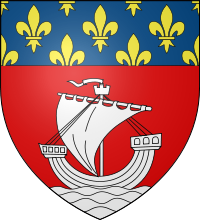- Count of Paris
-
- See Also:Countess of Paris
Count of Paris (French: Comte de Paris) was a title for the local magnate of the district around Paris in Carolingian times. Eventually, the count of Paris was elected to the French throne. The title died out with Paris a royal city, but it was revived later by the Orléanist pretenders to the French throne in a gesture of connection to the ancient Capetian family, and is currently used by Prince Henri, Count of Paris, Duke of France.
A fictional Count Paris is a character in William Shakespeare's famous tragedy Romeo and Juliet.
Contents
Pippinids
- Grifo (751-753), son of Charles Martel and his second wife, Swanahild
Girardids
- Gerard I (752-778)
- Stephen (778-811), son of previous
- Beggo (or Begon) (815-816), brother of previous
- Leuthard I of Paris (816), brother of Beggo and also count of Fézensac
- Gerard II (816), son of previous and brother of Adalard the Seneschal, also duke of Viennois
- Leuthard II of Paris (from 816), son of Beggo
- Adalard (877), count palatine, father of Adelaide, wife of Louis II of France
Welfs
- Conrad (858-859)
- Joseph (902-906)
Robertians
- Odo, also king of France (until 888)
- Robert, also count of Blois, Anjou, Tours, and Orléans, margrave of Neustria, and king of France (888-923)
- Hugh the Great (923-956)
- Hugh Capet (956-996)
Bouchardids
- Bouchard I the Venerable (1005), also count of Vendôme, Corbeil, and Melun
- Reginald, also bishop of Paris
Orléanists
The title was revived much later and was used by three claimants to the French throne:
- Louis-Philippe, Comte de Paris (1838-1894): French Orléanist monarchists referred to him as "Louis-Philippe II", and then later when Henri, comte de Chambord died, he was recognized as the royalist heir by almost all French monarchists, and was occasionally known as Philippe VII.
- Henri, Comte de Paris (1908-1999)
- Henri, Comte de Paris, Duc de France (born 1933)
The title was given by Louis-Philippe I to his grandson Philippe, as show of gratitude towards the City of Paris and in reference to the early ancestors of the Capetian dynasty.
Since 1830, there had been high controversy amongst French royalists. One group, called legitimists, recognised the senior branch of the family as heirs to the monarchy, while another group, the Orléanists, recognised Louis-Philippe and his heirs. In 1883, with the death of Henri, comte de Chambord, the senior branch of the family died out. His genealogical heir was Juan, Count of Montizón, but most legitimists recognised Philippe, Comte de Paris as heir to the comte de Chambord, because King Philip V of Spain, ancestor of the Count of Montizon, had renounced his rights to the French throne. A minority group of royalists refused to recognise the validity of these renunciations. Nowadays, they recognise Louis Alphonse, Duke of Anjou as heir to the French throne.
Thus, the Comte de Paris is presently the Orléanist pretender to the French throne.
See also
Categories:- Counts of Paris
Wikimedia Foundation. 2010.

